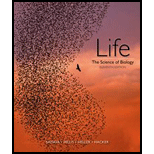
Life: The Science of Biology
11th Edition
ISBN: 9781319010164
Author: David E. Sadava, David M. Hillis, H. Craig Heller, Sally D. Hacker
Publisher: W. H. Freeman
expand_more
expand_more
format_list_bulleted
Concept explainers
Question
Chapter 32.2, Problem 2R
Summary Introduction
To review:
The ways in which the echinoderms obtain food using their tube feet. The comparison between this feeding mechanism with that of the hemichordates.
Introduction:
The echinoderms and the hemichordates fall under the deuterostome class. The former possesses a radial symmetry, while the latter possesses a bilateral symmetry. The body symmetry of these organisms enables two modes of feeding mechanisms.
The echinoderms possess water canals systems, which extend into tube feet outside their body. The tube feet functions as locomotor organs and at the same time, also serves the gaseous exchange. Along with the water, the food and gases diffuse into the water canal system through the tube feet.
Expert Solution & Answer
Want to see the full answer?
Check out a sample textbook solution
Students have asked these similar questions
Define "catch connective tissue". Using specific examples from three of the five major living groups of echinoderms, describe three different ways in which catch connective tissue facilitates food capture.
Why is the madreporite of sea cucumbers internal instead of external like other echinoderms?
Identify the distinguishing characteristics of echinoderms.
Chapter 32 Solutions
Life: The Science of Biology
Knowledge Booster
Learn more about
Need a deep-dive on the concept behind this application? Look no further. Learn more about this topic, biology and related others by exploring similar questions and additional content below.Similar questions
- How do each of the classes of Echinoderm feed?arrow_forwardHow are the echinoderms significant to the marine environment? Relate some (at least two) of their anatomical features that made them fitting for these purpose.arrow_forwardMollusks exhibit a variety of feeding methods. List at least four and discuss adaptations and examples for each type.arrow_forward
- ECHINODERMS a)- Describe in detail how is the Hydrostatic Vascular System (Aquifer) of the Echinoderms. b) Describe flake is gas exchange in Echinoderms. c) -Why are echinoderms specialists in regeneration?arrow_forwardMention three similarities between lancelet and ammocoetes?arrow_forwardBriefly describe the structure of nematodes and explain how it may be used to capture preyarrow_forward
- Describe the endoskeleton and other adaptations seen in echinoderms.arrow_forwardHow are the echinoderms significant to the marine environment? Relate at least three of their anatomical features that made them fitting for these purpose.arrow_forwardExplain how all echinoderms show five-sided radial symmetry when they look so different. How does a tube foot work? Explain using words and drawings. Most of the echinoderms have hard parts and spines for defense, but the sea cucumbers do not. How do sea cucumbers protect themselves from predators?arrow_forward
- The presence of a water vascular system is unique to Echinoderms. Describe using labelled diagramsthe water vascular system of the asteroids. List all the structures present as well as their functionsin this systemarrow_forwardWhat is the type of digestive system of echinoderms?arrow_forwardThere are different modes of respiration under the Phylum Echinodermata. Enumerate and add a short but concise explanation of each mode.arrow_forward
arrow_back_ios
SEE MORE QUESTIONS
arrow_forward_ios
Recommended textbooks for you
 Concepts of BiologyBiologyISBN:9781938168116Author:Samantha Fowler, Rebecca Roush, James WisePublisher:OpenStax College
Concepts of BiologyBiologyISBN:9781938168116Author:Samantha Fowler, Rebecca Roush, James WisePublisher:OpenStax College Human Physiology: From Cells to Systems (MindTap ...BiologyISBN:9781285866932Author:Lauralee SherwoodPublisher:Cengage Learning
Human Physiology: From Cells to Systems (MindTap ...BiologyISBN:9781285866932Author:Lauralee SherwoodPublisher:Cengage Learning

Concepts of Biology
Biology
ISBN:9781938168116
Author:Samantha Fowler, Rebecca Roush, James Wise
Publisher:OpenStax College

Human Physiology: From Cells to Systems (MindTap ...
Biology
ISBN:9781285866932
Author:Lauralee Sherwood
Publisher:Cengage Learning